...
The regulations require that all lamps on commercial motor vehicles (CMVs) must be capable of being operated at all times.
Scope
These requirements apply to CMVs operating in interstate commerce.
Regulatory citations
- 49 CFR 393 Subpart B — Lamps, reflective devices and electrical wiring
Key definitions
- Commercial motor vehicle (CMV): A self-propelled or towed motor vehicle used on a highway, in interstate commerce, that meets any one of the following criteria:
- Has a gross vehicle weight rating (GVWR) or gross combination weight rating (GCWR), or gross vehicle weight (GVW) or gross combination weight (GCW), of 10,001 pounds or more, whichever is greater; or
- Is designed or used to transport more than 8 passengers (including the driver) for compensation; or
- Is designed or used to transport more than 15 passengers (including the driver), and not used to transport passengers for compensation; or
- Is transporting hazardous materials of a type or quantity which requires placarding.
Summary of requirements
All lamps must be capable of being operated at all times.
All required lamps and reflective devices/material must not be obscured by the tailboard, by any part of the load, or be covered by dirt or other added vehicle or work equipment.
The following table lists the required lamps, reflective devices, and associated equipment by type of CMV. The illustrations that follow the table illustrate the position of the lamps, reflective devices, and associated equipment as specified in the table.
| Item on the vehicle | Qty. | Color | Location | Position | Height above the road surface in millimeters (mm) (with English units in parenthesis) measured from the center of the lamp at curb weight | Vehicles for which the devices are required |
|---|---|---|---|---|---|---|
| Legend: Types of commercial motor vehicles shown in the last column of Table 1. A. Buses and trucks less than 2,032 mm (80 inches) in overall width. B. Buses and trucks 2,032 mm (80 inches) or more in overall width. C. Truck tractors. D. Semitrailers and full trailers 2,032 mm (80 inches) or more in overall width except converter dollies. E. Converter dolly. F. Semitrailers and full trailers less than 2,032 mm (80 inches) in overall width. G. Pole trailers. H. Projecting loads. Note: Lamps and reflectors may be combined as permitted by 393.22 and S5.4 of 49 CFR 571.108, Equipment combinations. Footnote—1 Identification lamps may be mounted on the vertical centerline of the cab where different from the centerline of the vehicle, except where the cab is not more than 42 inches wide at the front roofline, then a single lamp at the center of the cab shall be deemed to comply with the requirements for identification lamps. No part of the identification lamps or their mountings may extend below the top of the vehicle windshield. Footnote—2 Unless the turn signals on the front are so constructed (double—faced) and located as to be visible to passing drivers, two turn signals are required on the rear of the truck tractor, one at each side as far apart as practicable. Footnote—3 The identification lamps need not be visible or lighted if obscured by a vehicle in the same combination. Footnote—4 Any semitrailer or full trailer manufactured on or after March 1, 1979, shall be equipped with rear side—marker lamps at a height of not less than 381 mm (15 inches), and on the rear of trailers not more than 1,524 mm (60 inches) above the road surface, as measured from the center of the lamp on the vehicle at curb weight. Footnote—5 Each converter dolly, when towed singly by another vehicle and not as part of a full trailer, shall be equipped with one stop lamp, one tail lamp, and two reflectors (one on each side of the vertical centerline, as far apart as practicable) on the rear. Each converter dolly shall be equipped with rear turn signals and vehicular hazard warning signal flasher lamps when towed singly by another vehicle and not as part of a full trailer, if the converter dolly obscures the turn signals at the rear of the towing vehicle. | ||||||
| Footnote—6 Pole trailers shall be equipped with two reflex reflectors on the rear, one on each side of the vertical centerline as far apart as practicable, to indicate the extreme width of the trailer. Footnote—7 Pole trailers, when towed by motor vehicles with rear identification lamps meeting the requirements of 393.11 and mounted at a height greater than the load being transported on the pole trailer, are not required to have rear identification lamps. Footnote—8 Pole trailers shall have on the rearmost support for the load: (1) two front clearance lamps, one on each side of the vehicle, both on the same level and as high as practicable to indicate the overall width of the pole trailer; (2) two rear clearance lamps, one on each side of the vehicle, both on the same level and as high as practicable to indicate the overall width of the pole trailer; (3) two rear side marker lamps, one on each side of the vehicle, both on the same level, not less than 375 mm (15 inches) above the road surface; (4) two rear reflex reflectors, one on each side, both on the same level, not less than 375 mm (15 inches) above the road surface to indicate maximum width of the pole trailer; and (5) one red reflector on each side of the rearmost support for the load. Lamps and reflectors may be combined as allowed in 393.22. Footnote—9 Any motor vehicle transporting a load which extends more than 102 mm (4 inches) beyond the overall width of the motor vehicle shall be equipped with the following lamps in addition to other required lamps when operated during the hours when headlamps are required to be used. (1) The foremost edge of that portion of the load which projects beyond the side of the vehicle shall be marked (at its outermost extremity) with an amber lamp visible from the front and side. (2) The rearmost edge of that portion of the load which projects beyond the side of the vehicle shall be marked (at its outermost extremity) with a red lamp visible from the rear and side. (3) If the projecting load does not measure more than 914 mm (3 feet) from front to rear, it shall be marked with an amber lamp visible from the front, both sides, and rear, except that if the projection is located at or near the rear it shall be marked by a red lamp visible from front, side, and rear. Footnote—10 Projections beyond rear of motor vehicles. Motor vehicles transporting loads which extend more than 1,219 mm (4 feet) beyond the rear of the motor vehicle, or which have tailboards or tailgates extending more than 1,219 mm (4 feet) beyond the body, shall have these projections marked as follows when the vehicle is operated during the hours when headlamps are required to be used: (1) On each side of the projecting load, one red side marker lamp, visible from the side, located so as to indicate maximum overhang. (2) On the rear of the projecting load, two red lamps, visible from the rear, one at each side; and two red reflectors visible from the rear, one at each side, located so as to indicate maximum width. Footnote—11 To be illuminated when headlamps are illuminated. No rear license plate lamp is required on vehicles that do not display a rear license plate. Footnote—12 Every bus, truck, and truck tractor shall be equipped with a signaling system that, in addition to signaling turning movements, shall have a switch or combination of switches that will cause the two front turn signals and the two rear signals to flash simultaneously as a vehicular traffic signal warning, required by 392.22(a). The system shall be capable of flashing simultaneously with the ignition of the vehicle on or off. | ||||||
| Footnote—13 To be actuated upon application of service brakes. Footnote—14 Backup lamp required to operate when bus, truck, or truck tractor is in reverse. Footnote—15 (1) For the purposes of 393.11, the term “overall width” refers to the nominal design dimension of the widest part of the vehicle, exclusive of the signal lamps, marker lamps, outside rearview mirrors, flexible fender extensions, and mud flaps. (2) Clearance lamps may be mounted at a location other than on the front and rear if necessary to indicate the overall width of a vehicle, or for protection from damage during normal operation of the vehicle. (3) On a trailer, the front clearance lamps may be mounted at a height below the extreme height if mounting at the extreme height results in the lamps failing to mark the overall width of the trailer. (4) On a truck tractor, clearance lamps mounted on the cab may be located to indicate the width of the cab, rather than the width of the vehicle. (5) When the rear identification lamps are mounted at the extreme height of a vehicle, rear clearance lamps are not required to be located as close as practicable to the top of the vehicle. Footnote—16 A trailer subject to this part that is less than 1829 mm (6 feet) in overall length, including the trailer tongue, need not be equipped with front side marker lamps and front side reflex reflectors. Footnote—17 A boat trailer subject to this part whose overall width is 2032 mm (80 inches) or more need not be equipped with both front and rear clearance lamps provided an amber (front) and red (rear) clearance lamp is located at or near the midpoint on each side so as to indicate its extreme width. | ||||||
| Headlamps | 2 | White | Front | On the front at the same height, with an equal number at each side of the vertical center line as far apart as practicable. | Not less than 559 mm (22 inches) nor more than 1,372 mm (54 inches). | A, B, C |
| Turn signal (front). See footnotes #2 and 12. | 2 | Amber | At or near the front. | One on each side of the vertical centerline at the same height and as far apart as practicable. | Not less than 381 mm (15 inches) nor more than 2,108 mm (83 inches). | A, B, C |
| Identification lamps (front). See footnote #1. | 3 | Amber | Front | As close as practicable to the top of the vehicle, at the same height, and as close as practicable to the vertical centerline of the vehicle (or the vertical centerline of the cab where different from the centerline of the vehicle) with lamp centers spaced not less than 152 mm (6 inches) or more than 305 mm (12 inches) apart. Alternatively, the front lamps may be located as close as practicable to the top of the cab. | All three on the same level as close as practicable to the top of the motor vehicle. | B, C |
| Tail lamps. See footnotes #5 and 11. | 2 | Red | Rear | One lamp on each side of the vertical centerline at the same height and as far apart as practicable. | Both on the same level between 381 mm (15 inches) and 1,829 mm (72 inches). | A, B, C, D, E, F, G, H |
| Stop lamps. See footnotes #5 and 13. | 2 | Red | Rear | One lamp on each side of the vertical centerline at the same height and as far apart as practicable. | Both on the same level between 381 mm (15 inches) and 1,829 mm (72 inches). | A, B, C, D, E, F, G |
| Clearance lamps. See footnotes #8, 9, 10, 15 & 17. | 2 | Amber | One on each side of the front of the vehicle. | One on each side of the vertical centerline to indicate overall width. | Both on the same level as high as practicable. | B, C, D, G, H |
| 2 | Red | One on each side of the rear of the vehicle. | One on each side of the vertical centerline to indicate overall width. | Both on the same level as high as practicable. | B, D, G, H | |
| Reflex reflector, intermediate (side). | 2 | Amber | One on each side. | At or near the midpoint between the front and rear side marker lamps, if the length of the vehicle is more than 9,144 mm (30 feet). | Between 381 mm (15 inches) and 1,524 (60 inches). | A, B, D, F, G |
| Reflex reflector (rear). See footnotes #5, 6, and 8. | 2 | Red | Rear | One on each side of the vertical centerline, as far apart as practicable and at the same height. | Both on the same level, between 381 mm (15 inches) and 1,524 mm (60 inches). | A, B, C, D, E, F, G |
| Reflex reflector (rear side). | 2 | Red | One on each side (rear). | As far to the rear as practicable. | Both on the same level, between 381 mm (15 inches) and 1,524 mm (60 inches). | A, B, D, F, G |
| Reflex reflector (front side). See footnote #16. | 2 | Amber | One on each side (front). | As far to the front as practicable. | Between 381 mm (15 inches) and 1,524 mm (60 inches). | A, B, C, D, F, G |
| License plate lamp (rear). See footnote #11. | 1 | White | At rear license plate to illuminate the plate from the top or sides. | No requirements | A, B, C, D, F, G | |
| Side marker lamp (front). See footnote #16. | 2 | Amber | One on each side. | As far to the front as practicable. | Not less than 381 mm (15 inches). | A, B, C, D, F |
| Side marker lamp intermediate. | 2 | Amber | One on each side. | At or near the midpoint between the front and rear side marker lamps, if the length of the vehicle is more than 9,144 mm (30 feet). | Not less than 381 mm (15 inches). | A, B, D, F, G |
| Side marker lamp (rear). See foot- notes #4 and 8. | 2 | Red | One on each side. | As far to the rear as practicable. | Not less than 381 mm (15 inches), and on the rear of trailers not more than 1,524 mm (60 inches). | A, B, D, F, G |
| Turn signal (rear). See footnotes #5 and 12. | 2 | Amber or red | Rear | One lamp on each side of the vertical centerline as far apart as practicable. | Both on the same level, between 381 mm (15 inches) and 2,108 mm (83 inches). | A, B, C, D, E, F, G |
| Identification lamp (rear). See footnotes #3, 7, and 15. | 3 | Red | Rear | One as close as practicable to the vertical centerline. One on each side with lamp centers spaced not less than 152 mm (6 inches) or more than 305 mm (12 inches) apart. | All three on the same level as close as practicable to the top of the vehicle. | B, D, G |
| Vehicular hazard warning signal flasher lamps. See footnotes #5 and 12. | 2 | Amber | Front | One lamp on each side of the vertical centerline, as far apart as practicable. | Both on the same level, between 381 mm (15 inches) and 2,108 mm (83 inches). | A, B, C |
| 2 | Amber or red | Rear | One lamp on each side of the vertical centerline, as far apart as practicable. | Both on the same level, between 381 mm (15 inches) and 2,108 mm (83 inches). | A, B, C, D, E, F, G | |
| Backup lamp. See footnote #14. | 1 or 2 | White | Rear | Rear | No requirement | A, B, C |
| Parking lamp | 2 | Amber or white | Front | One lamp on each side of the vertical centerline, as far apart as practicable. | Both on the same level, between 381 mm (15 inches) and 2,108 mm (83 inches). | A |
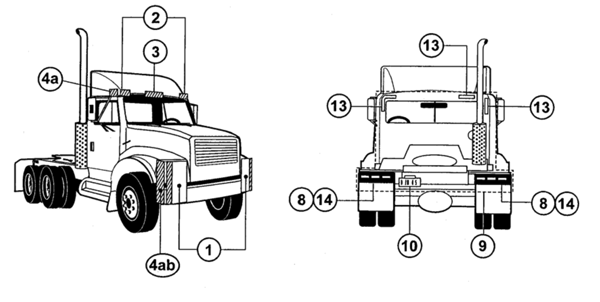 |
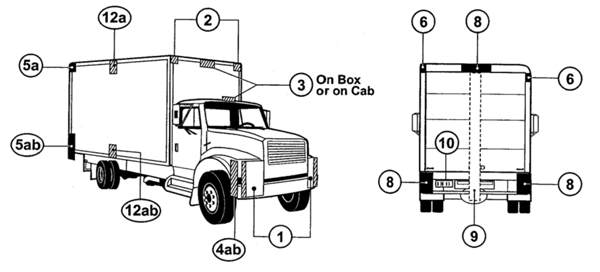 |
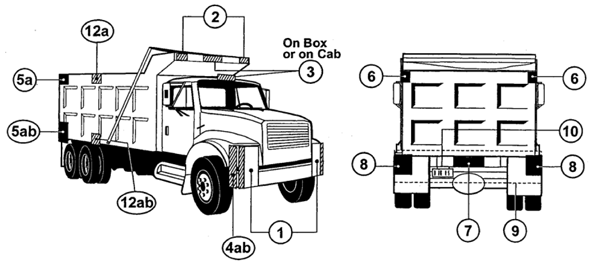 |
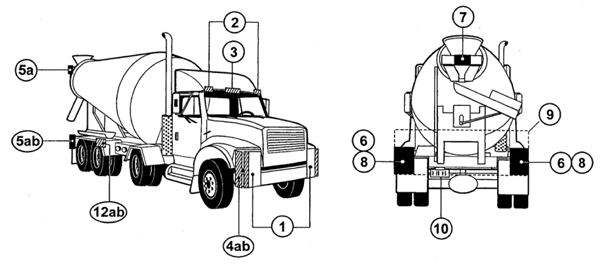 |
 |
 |
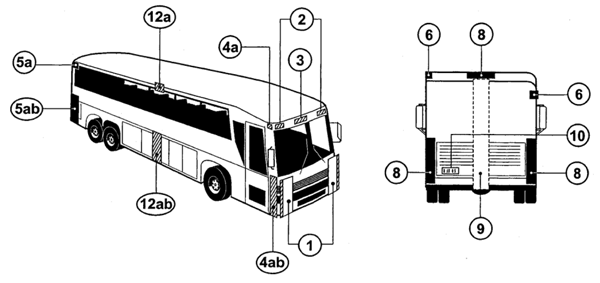 |
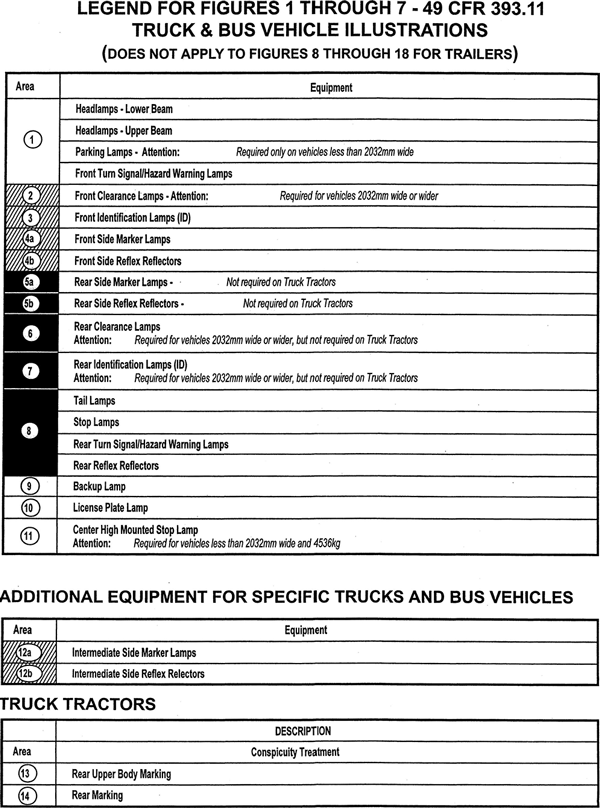
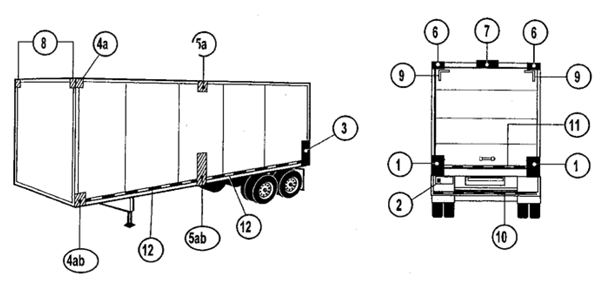 |
 |
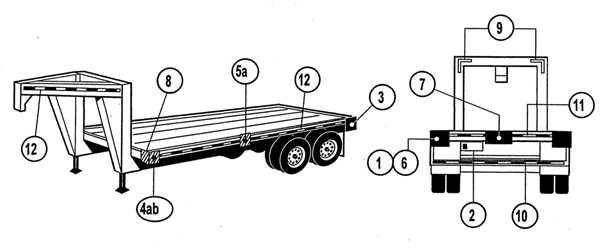 |
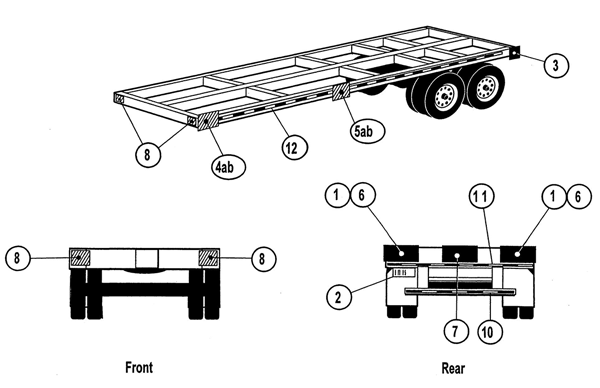 |
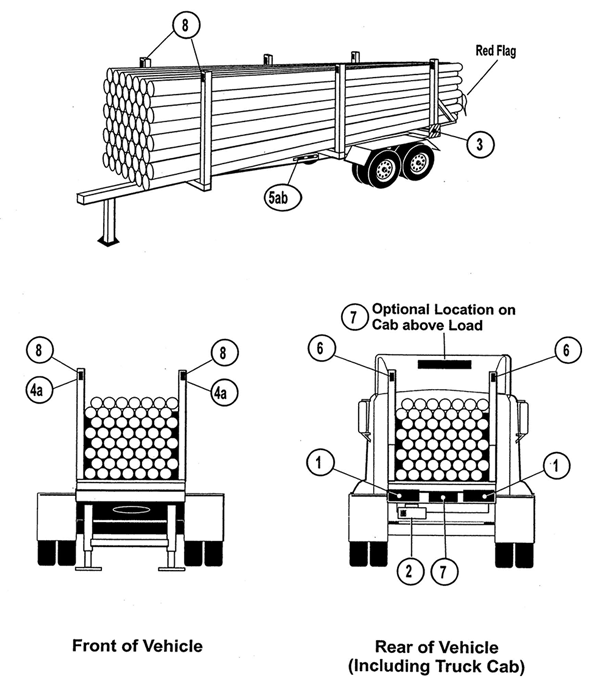 |
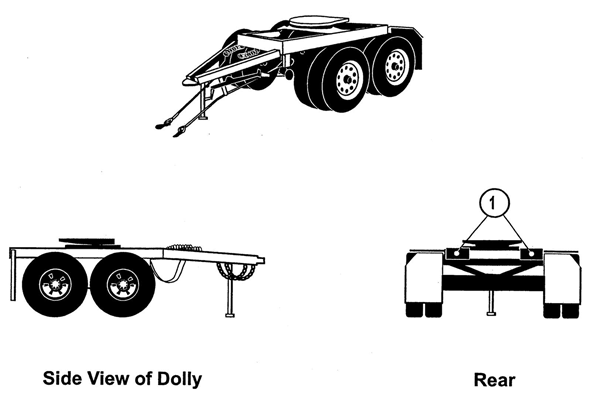 |
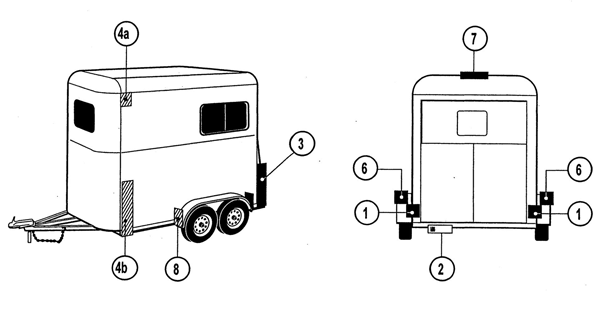 |
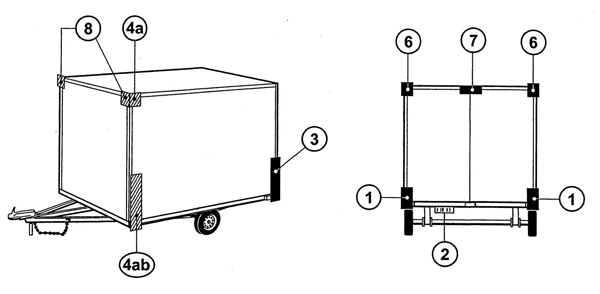 |
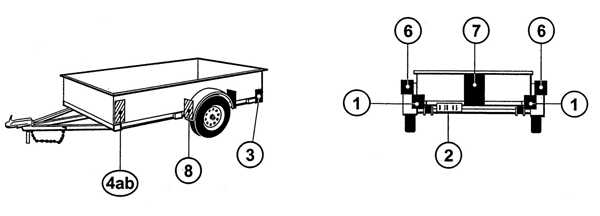 |
 |
 |
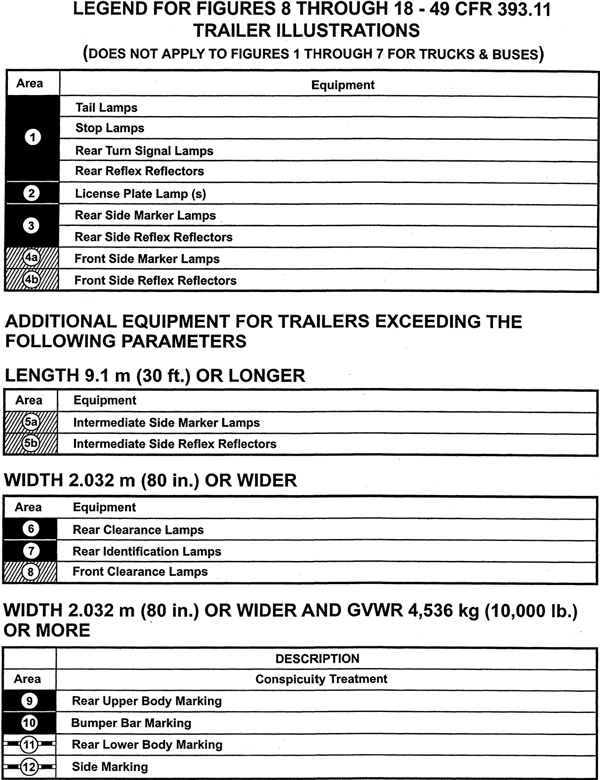
Exceptions. Trailers which are equipped with conspicuity material which meets the requirements of 393.11(b) are not required to be equipped with the reflex reflectors listed in the table if:
- The conspicuity material is placed at the locations where reflex reflectors are required by the table, and
- The conspicuity material when installed on the motor vehicle meets the visibility requirements for the reflex reflectors.
